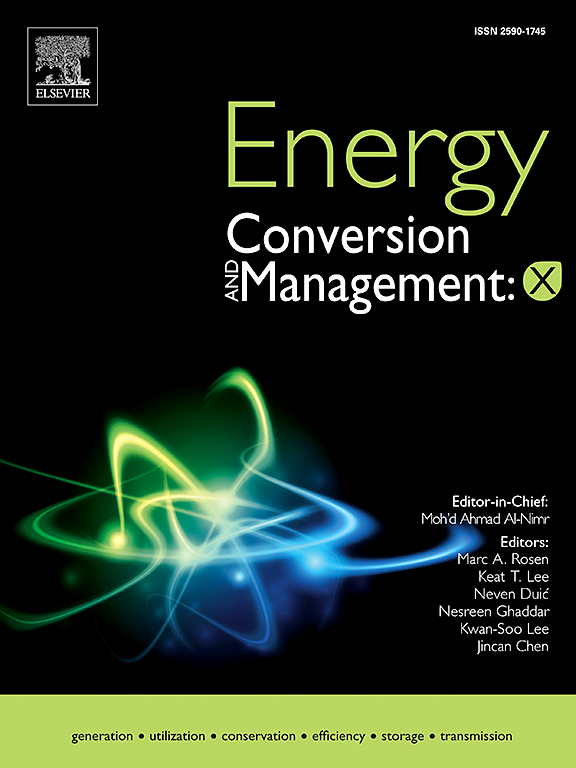Technoeconomics of a molten salt/supercritical carbon dioxide heat exchanger with fractal-textured corrosion resistant coatings for concentrating solar thermal systems
IF 10.9
1区 工程技术
Q1 ENERGY & FUELS
引用次数: 0
Abstract
Molten salt/supercritical carbon dioxide heat exchangers are integral to the operation of Generation 3 concentrating solar thermal systems, which play a key role in facilitating the decarbonization of power generation and industrial sectors by reducing reliance on fossil fuels and curbing greenhouse gas emissions. At the targeted operating temperatures of about 750 °C, molten carbonate and molten chloride salts are two viable heat transfer fluids and thermal energy storage media. However, their extreme corrosivity at high temperatures limits the containment materials choice to expensive alloys such as Haynes 230, which increases the levelized cost of energy. Toward addressing the materials and cost challenge, this paper presents a detailed technoeconomic analysis of a molten salt/supercritical carbon dioxide heat exchanger made of low-cost ferrous alloys with novel fractal-textured corrosion-resistant coatings as tube and shell materials. The coatings impressively reduce the corrosion rate on the alloys to be lower than or on par with Haynes 230. Considering different alloy materials, the study systematically demonstrates that the levelized cost of a heat exchanger with coated low-cost ferrous alloys is lower than that with Haynes 230 by 60 % and 63 % for molten carbonate and chloride salts, respectively. The study establishes for the first time that low-cost ferrous alloys with fractal textured corrosion-resistant coatings are technoeconomically superior alternatives to Haynes 230 in Gen3 CSP systems, with broader application to molten salt nuclear reactor systems as well.
聚光太阳能热系统熔盐/超临界二氧化碳热交换器的分形织体耐腐蚀涂层技术经济学
熔盐/超临界二氧化碳热交换器是第三代聚光太阳能热系统不可或缺的一部分,它通过减少对化石燃料的依赖和抑制温室气体排放,在促进发电和工业部门脱碳方面发挥着关键作用。在750℃左右的目标工作温度下,熔融碳酸盐和熔融氯化物盐是两种可行的传热流体和热能储存介质。然而,它们在高温下的极端腐蚀性限制了密封材料的选择,如Haynes 230等昂贵的合金,这增加了能源的平化成本。为了解决材料和成本方面的挑战,本文对采用新型分形结构耐腐蚀涂层作为管壳材料的低成本亚铁合金制成的熔盐/超临界二氧化碳换热器进行了详细的技术经济分析。该涂层显著降低了合金的腐蚀速率,低于或与Haynes 230相当。在考虑不同合金材料的情况下,研究系统地表明,在熔融碳酸盐和氯化物盐的情况下,涂层低成本铁合金换热器的平准化成本分别比Haynes 230换热器低60%和63%。该研究首次证明,具有分形织构耐腐蚀涂层的低成本铁合金在技术经济上优于Gen3 CSP系统中的Haynes 230,在熔盐核反应堆系统中也有更广泛的应用。
本文章由计算机程序翻译,如有差异,请以英文原文为准。
求助全文
约1分钟内获得全文
求助全文
来源期刊

Energy Conversion and Management
工程技术-力学
CiteScore
19.00
自引率
11.50%
发文量
1304
审稿时长
17 days
期刊介绍:
The journal Energy Conversion and Management provides a forum for publishing original contributions and comprehensive technical review articles of interdisciplinary and original research on all important energy topics.
The topics considered include energy generation, utilization, conversion, storage, transmission, conservation, management and sustainability. These topics typically involve various types of energy such as mechanical, thermal, nuclear, chemical, electromagnetic, magnetic and electric. These energy types cover all known energy resources, including renewable resources (e.g., solar, bio, hydro, wind, geothermal and ocean energy), fossil fuels and nuclear resources.
 求助内容:
求助内容: 应助结果提醒方式:
应助结果提醒方式:


